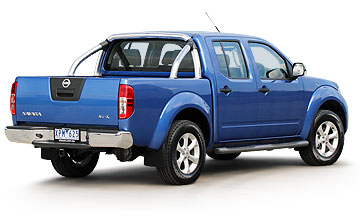BY JAMES STANFORD | 23rd Mar 2010

The visual difference between the two D40 models is not dramatic, but the Thai-built King Cab misses out on upgrades such as electronic stability control (on diesel models), extra airbags, improved interior and upgraded diesel engine.
Nissan is not sure when they will be available.
The newly facelifted ST-X Crew Cab is a capable commercial vehicle and one of the best examples of why more customers are buying utes that double as family cars after work and at weekends.
It still isn’t the perfect family car, as the rear seats aren’t as comfortable as those of a sedan, but they are better than the pews in a lot of competing crew-cabs.
For those wanting to carry loved ones in those rear seats, side and curtain airbags have been added, along with that other proven lifesaver – electronic stability control – which, unfortunately, is still light on the ground in the commercial vehicle arena.
However, it should be noted that the ESC is only available on the diesel model, not the petrol.
Why? Nissan says it’s not available from the factory. Another example of why you need to double check which Navara you are buying and exactly what features you will be getting.
The slow-selling petrol model retains its existing engine.
The revised diesel, which we tested, is now class leading. This revised 2.5-litre diesel was always admirable, but the changes have not only tapped more power and torque, but also made it more refined.
It is so strong that, unladen at least, engine hardly needs to be pushed.
We didn’t cover enough ground on the test to get an accurate fuel reading, but the 14 per cent promised saving, meaning an average of 8.5L/100km for the diesel manual, should make a difference to the weekly fuel bill.
A heap of urge is available from just above 1200rpm, and this engine is happy working at the low end of the rev-range.
It also seems quieter and smoother than most other commercial ute diesels.
The easy-shifting manual gearbox has six-speeds – not a given in these kinds of utes.
That can make a big difference for those doing a lot of highway work.
The five-speed automatic is no stand out, but gains a manual mode for those wanting to lock it in a gear for off-road work or carrying loads up hills.
Navara owners might be able to see them, but the exterior revisions don’t stand out to most people.
Nissan officials spent several minutes pointing out the differences made to the front end, but you still need to park the current car and the facelifted model next to each other to spot the differences.
The company was probably reluctant to alter the design too much because it has been so well received. In my opinion the Navara is one of the better looking Japanese-developed utes. That said, it seems a waste of money to change things such as the bonnet, bumper, grille and headlights for such minor benefit.
The most visible design change is probably the addition of 17-inch alloys, up from 16-inch.
Interior changes are also more obvious. The centre console now has a metal-look finish, as do the steering wheel arms, lifting the ambience. Ditto the switchgear.
Chrome trim now surrounds the cup-holders and the gear-shifter, while seats get a classier new seat trim, as do the doors where the fabric runs higher.
It doesn’t sound like much, but sitting in the two models shows, the improvement is tangible.
The facelifted model adds dual-zone climate control, Bluetooth, an Aux input for the sound system and steering-wheel controls.
Driving the Navara on a mix of tarmac and dirt roads proved it is one of the best-riding utes in the class, along with Toyota’s HiLux.
That said, a recent preview of the Volkswagen Amarok suggests VW could give them both a shake, thanks to a super-strong new body and excellent suspension.
The Navara is reasonably civilised over bumps and ruts, and despite some body wobble, it is better than most in the class. Easy to drive on the road, it does not wander offline like some.
Its offroad ability is quite amazing, enhanced by improved ground clearance, thanks to the new bumper.
None of the facelift upgrades come free, and the price increases of between $2070 and $3130 are steep.
If you are after a premium crew cab ute that can also carry the kids after work and at weekends, the revised D40 Navara would have to be one of the best, if not the best, option on the market.
It’s a shame that the petrol version doesn’t have ESC and that the king cab versions miss out on all the revisions.